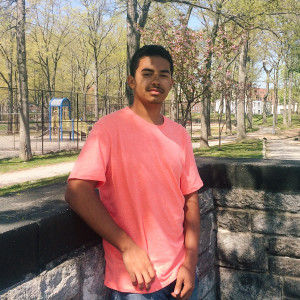Age: 14
Neighborhood: Norwood, Bronx
Middle school: P.S. / M.S. 280
High school: Bard High School Early College in Queens

To Johnathan Lugo, eighth grade has felt like a juggling act.
Putting together applications for high schools, preparing for the Specialized High School Admissions Test and keeping his grades up, made this a stressful year. The biggest hurdle was sifting through all the 400 options to find a high school that would be a good fit for him – one that allowed him to leave the Bronx.
“I’m not saying the Bronx is a bad place,” Johnathan said, “It’s just that I’ve been living in it for 14 years.”
The only certain fall back options are zoned high schools and Johnathan’s neighborhood, Norwood, has two: DeWitt Clinton and Evander Childs High School.
DeWitt Clinton, in the Kingsbridge section of the Bronx, is one of the last large, comprehensive high schools in the city; many others have been closed, their buildings split up for several smaller, more specialized schools to share the facility. Clinton recently lost half its enrollment, going from 5,000 to 2,200 in 2013, the result of a Department of Education decision that many feared meant the beginning of the end for the institution.
The school struggles with overall low attendance and a low graduation rate, according to data. Just two miles away, Evander Childs High School has faced many of the same challenges. Johnathan described it as simply “a bad school.” For years, it had a reputation in the area for violence, disorder and a low graduation rate. Eight years ago, Evander Childs closed and reopened as a complex of six small (400 to 500 students), specialized schools. According to some reports, the schools are reinventing themselves with better reputations than their predecessor.
But Johnathan had his sights set on more accelerated programs than either neighborhood school offered, and he wanted to leave the Bronx. He has attended the same school since kindergarten: P.S./ M.S. 280, a mere three-minute walk from his house. The school is largely Latino, with 95 percent of its 900-student population qualifying for free and reduced lunch. Its test scores, attendance rates and parent engagement levels, according to surveys, are average for the city.
The process of researching and finding good programs, with a reasonable commute time from his neighborhood, was straightforward but daunting.
“There was no challenge with it,” he said about the application. “It was just, it made me anxious.”
Luckily, Johnathan had a lot of outside support. That made navigating the applications much easier. The complicated high school choice process is straightforward – if you have a guide, he explained. His seventh grade math teacher, Ashley Palumbo, provided a lot of help. She wrote him a recommendation letter, took him to some of the open houses, edited his essay and helped him finalize his list. The months-long wait for a decision was tough, and when the decision letters came out, it felt a little surreal.
“The whole day everyone was just talking about it,” Johnathan said. “It was a pretty weird day but when we got the letters and we opened them, everyone looked happy to me”
He was certainly happy: he opened his envelope to find he had gotten into his first choice, Bard High School Early College in Queens.
If Bard hadn’t worked out, things wouldn’t have been terrible, Johnathan said. His older sister applied to high schools herself a few years ago and didn’t get matched. She ended up at DeWitt Clinton High School, and while it wasn’t a bad experience for her, but Johnathan was more interested in expanding his horizons.
“I want to travel a little so I can actually see the city I live in, not just stay in one
borough,” he said.
The largest racial group in his high school is white (40 percent); with Blacks, Asians and Hispanics each at around 20 percent. Only about a third of the kids qualify for the free lunch program. The total enrollment is just 500 students.
***
Throughout the applications, his parents were supportive, but it was the staff at a summer program Johnathan attended, the Bridge to Enter Advanced Mathematics, and Palumbo who pushed him to apply to the schools on his final list.
He saw some of his peers struggling because they didn’t have the same kind of support, whereas, he said, “I was basically done with my list even before we got our applications.”
He said he had classmates who didn’t fulfill their potential in the application process. Some of them ended up unmatched in round one and will be enrolling at DeWitt Clinton in the fall. Others are still waiting on round two schools. Johnathan thinks they could have gotten into better schools with more help, like he had.
And even despite assistance, he harbored fears.
“When it came to filling it out, I got nervous,” he said, “I was thinking of all the bad things that can happen.”
